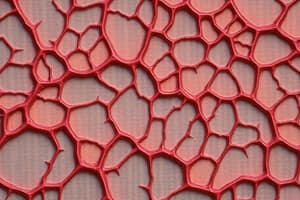Podcast
Questions and Answers
Which type of connective tissue provides flexibility and strength without much tension and compression resistance?
Which type of connective tissue provides flexibility and strength without much tension and compression resistance?
- Cartilage (correct)
- Bone
- Blood
- Adipose
What is the main function of epithelial tissue in the body?
What is the main function of epithelial tissue in the body?
- To circulate oxygen, nutrients, and waste materials
- To form surface layers, line body cavities, and be part of glands (correct)
- To store lipid reserves for energy
- To participate in the immune response
Which type of connective tissue stores lipid reserves for energy and thermal insulation?
Which type of connective tissue stores lipid reserves for energy and thermal insulation?
- Cartilage
- Blood
- Adipose (correct)
- Bone
What is the role of blood as a type of connective tissue?
What is the role of blood as a type of connective tissue?
Which function does epithelial tissue primarily serve?
Which function does epithelial tissue primarily serve?
What is the main purpose of lymph as a type of connective tissue?
What is the main purpose of lymph as a type of connective tissue?
What is the function of absorption in the context of cell activity?
What is the function of absorption in the context of cell activity?
Which process involves separating soluble substances from insoluble ones?
Which process involves separating soluble substances from insoluble ones?
What is the main function of connective tissue in relation to epithelial tissue?
What is the main function of connective tissue in relation to epithelial tissue?
Which tissue acts as a barrier between epithelial tissue and underlying connective tissue?
Which tissue acts as a barrier between epithelial tissue and underlying connective tissue?
Study Notes
Connective Tissue and Epithelial Tissue Overview
Connective tissue and epithelial tissue are two fundamental types of animal tissue, each serving specific roles in the body.
Connective Tissue
Connective tissue provides structural support, binds body organs together, and helps in the passage of nutrients and waste materials. It consists of cells embedded in a matrix of fibers and a liquid substance called plasma. There are different types of connective tissue adapted to serve particular needs, including:
- Adipose: Stores lipid reserves for energy and thermal insulation.
- Cartilage: Provides flexibility and strength without much tension and compression resistance.
- Bone: Offers rigidity and strength while bearing weight, supporting soft tissues, and providing attachment sites for muscles.
- Blood: Circulates oxygen, nutrients, and waste materials, as well as hosts immune cells.
- Lymph: Participates in the immune response and filters foreign particles from the bloodstream.
Epithelial Tissue
Epithelial tissue forms the surface layers of the body, lines body cavities and hollow organs, and is part of glands. It comes in various forms, ranging from thin, protective sheets to multi-layered barriers. Epithelial tissue serves several functions, including:
- Protection: Preventing entry of harmful substances.
- Secretion: Producing and releasing chemicals into surrounding environments.
- Absorption: Taking in substances through the cell walls.
- Excretion: Eliminating waste products.
- Filtration: Separating soluble substances from insoluble ones.
- Diffusion: Passing substances like oxygen and carbon dioxide across cell membranes.
- Sensory reception: Detecting stimuli like touch and light.
Relationship Between Connective and Epithelial Tissue
Epithelial tissue is typically covered by connective tissue, forming a boundary known as the basement membrane. This membrane acts as a barrier between the epithelial tissue and the underlying connective tissue, allowing for controlled interactions between the two. The connective tissue beneath the epithelial tissue provides structural support and supplies nutrients to the overlying tissues.
In summary, both connective and epithelial tissues play crucial roles in maintaining the structure and function of our bodies. They work closely together, with connective tissue providing support and nourishment, while epithelial tissue offers protection and facilitates the exchange of substances between body compartments.
Studying That Suits You
Use AI to generate personalized quizzes and flashcards to suit your learning preferences.
Description
Test your knowledge on the characteristics, functions, and relationships between connective tissue and epithelial tissue in the human body. Learn about the different types of connective tissue, roles of epithelial tissue, and how they work together to maintain bodily functions.




